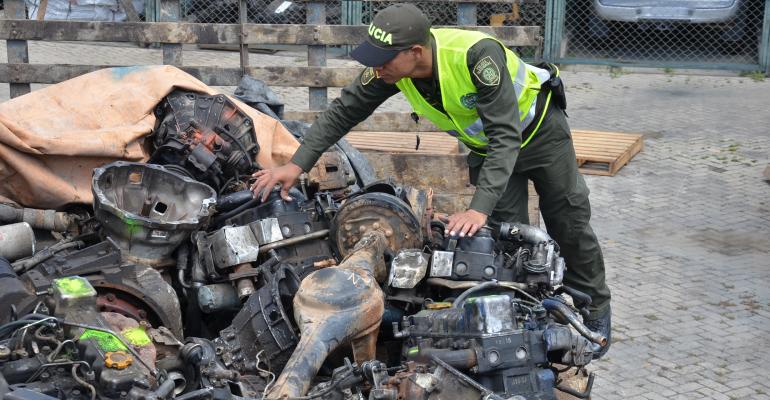MEDELLIN, Colombia – The smuggling of auto parts and vehicles into Colombia is a billion- dollar trade that has long shackled the sector’s potential for growth.
This contraband trade now finds itself squeezed between market forces on one side and a government clampdown on the other, but industry opinion is divided over whether it will be enough to halt the smuggling wave.
The trade in contraband auto parts alone costs the Colombian automotive sector an estimated $2.3 billion a year, representing over one-third of 2013 sales, Colombia’s auto-parts industry association ASOPARTES estimates.
The contraband trade “generates unemployment, failure to pay taxes, the deaths of people that try to impede this crime and the reduction of profits for legally constituted businesses,” says ASOPARTES President Tulio Zuloaga.
Contraband auto-parts smuggling also can put consumers at risk as the products are of unknown origin and come with no guarantees of quality.
People “are buying products without proof of their safety, and this can have enormous consequences for their family in terms of vehicle safety,” says Juan Camilo Nariño, vice president-commerce at ANDI, Colombia’s business association.
According to ASOPARTES, the most commonly smuggled products are spark plugs, shock absorbers, brake parts, engine parts, batteries, vehicle stickers, terminals, bearings and tires. The products are sourced from all over the world, in particular from the U.S., Asia, Europe and Latin American countries such as Venezuela and Panama.
Most parts enter using false or manipulated documents and pass through the country’s ports. The most popular entry point is the Pacific Coast port of Buenaventura, where 64% of the 61,878 units that authorities seized between January and September this year were discovered.
The parts commonly are sold in Colombia’s main cities, especially Bogota, Medellin and Cali.
“There are zones – which are plainly identified – in the big cities that are immense areas of trading of all types of auto parts and other (auto) products and the overwhelming majority are informal, which makes for an easier route for contraband,” says Camilo Llinas, president of ACOLFA, the association of local auto parts makers.
There also is a thriving contraband trade along the border with neighboring Venezuela, where runaway inflation and the artificially low exchange rate imposed by the Venezuelan government have created enormous price discrepancies.
According to Colombia’s tax and customs police (Policia Fiscal y Aduanera – POLFA) in the border town of Cucuta, the most commonly smuggled parts in the region are patched-up secondhand tires and motors, which can double in value just crossing the border.
However, the trade in the border region is focused less on auto parts than on assembled vehicles. Between January and September, the POLFA seized 434 vehicles, 227 of which were confiscated in the border region.
Businesses in the area take advantage of the fact locals are allowed to purchase Venezuelan vehicles for their own use. They obtain inexpensive Venezuelan vehicles, then illegally sell them unregistered.
The practice shows “people here have an attitude (toward business) that is an attitude of illegality, which we are trying to change to make people think about their work in a way that is transparent and honest,” says Lt. Col. Rodolfo Carrero, head of the POLFA in Cucuta.
Some in the industry believe the tide may be turning against the contraband trade, not because of a change in attitude but thanks to what is more commonly seen as a menace to the sector: a flood of inexpensive Chinese imports.
“Contraband is disappearing because consumers prefer low prices…and not products that they don’t even know where they have come from,” Llinas says.
The only exception is tires, which still are smuggled into the country in large numbers as a result of anti-dumping measures Colombia has taken against China, ensuring high tariffs on legal tire imports remain in place, he says.
Consumers could resume buying legal Colombian products if doubts grow over the quality of the smuggled Chinese parts, Llinas suggests.
“Later, when they find out more about the Chinese products, they are not going to return to contraband but to national products, which are getting more competitive, efficient and cheaper every day,” he says.
But it is not just market forces that are making inroads against the contraband trade. Both the industry and the state are combating smuggling.
Over the past year, industry groups such as ASOPARTES and ACOLFA have been working with the government on anti-contraband campaigns and formalization processes for informal businesses.
In addition, the POLFA has been reformed and reinforced and by September already had seized auto parts worth 365% more than the total for 2013 and confiscated vehicles worth 63% more.
Despite these advances, many in the sector aren’t convinced enough is being done to stem the flow of contraband.
“People need to have the awareness that taking part in contraband smuggling in one way or another is a serious issue,” Zuloaga says. “The current measures are not enough. The actions need to be compelling, and smugglers should not only pay with fines but also with prison.”





